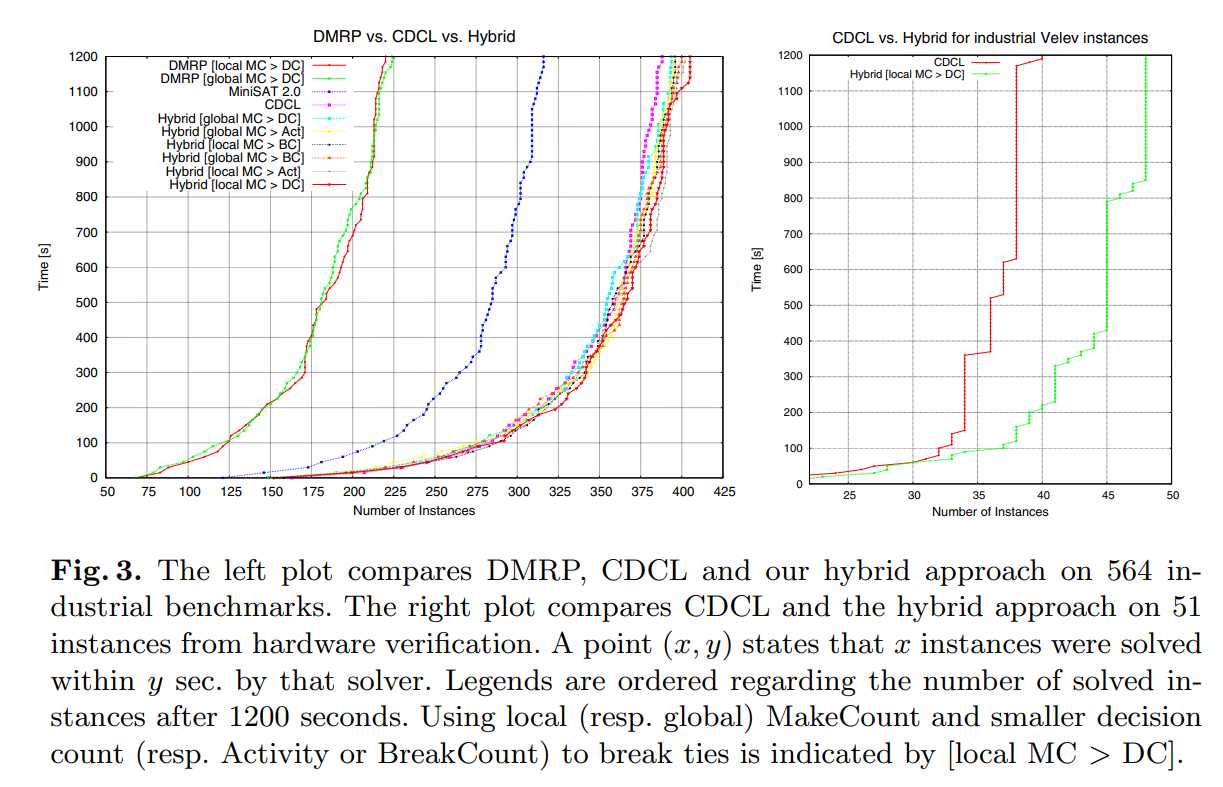-
1.Bacchus, F.: Exploring the computational tradeoff of more reasoning and less searching. In: SAT 2002, pp. 7–16 (2002)Google Scholar
-
2.Biere, A.: Adaptive restart strategies for conflict driven SAT solvers. In: Kleine Büning, H., Zhao, X. (eds.) SAT 2008. LNCS, vol. 4996, pp. 28–33. Springer, Heidelberg (2008)CrossRefGoogle Scholar
-
3.Biere, A.: Picosat essentials. JSAT 4, 75–97 (2008)zbMATHGoogle Scholar
-
4.Davis, M., Logemann, G., Loveland, D.: A machine program for theorem-proving. ACM Commun. 5(7), 394–397 (1962)MathSciNetCrossRefzbMATHGoogle Scholar
-
5.Davis, M., Putnam, H.: A computing procedure for quantification theory. J. ACM 7(3), 201–215 (1960)MathSciNetCrossRefzbMATHGoogle Scholar
-
6.Eén, N., Sörensson, N.: An extensible SAT-solver. In: Giunchiglia, E., Tacchella, A. (eds.) SAT 2003. LNCS, vol. 2919, pp. 502–518. Springer, Heidelberg (2004)CrossRefGoogle Scholar
-
7.Fukunaga, A.S.: Efficient Implementations of SAT Local Search. In: SAT (2004)Google Scholar
-
8.Goldberg, E.: Determinization of resolution by an algorithm operating on complete assignments. In: Biere, A., Gomes, C.P. (eds.) SAT 2006. LNCS, vol. 4121, pp. 90–95. Springer, Heidelberg (2006)CrossRefGoogle Scholar
-
9.Goldberg, E.: A decision-making procedure for resolution-based SAT-solvers. In: Kleine Büning, H., Zhao, X. (eds.) SAT 2008. LNCS, vol. 4996, pp. 119–132. Springer, Heidelberg (2008)CrossRefGoogle Scholar
-
10.Ivancic, F., Yang, Z., Ganai, M., Gupta, A., Ashar, P.: Efficient SAT-based bounded model checking for software verification. Theoretical Computer Science 404(3) (2008)Google Scholar
-
11.Kautz, H.A., Selman, B.: Planning as satisfiability. In: Proceedings of the Tenth European Conference on Artificial Intelligence ECAI 1992, pp. 359–363 (1992)Google Scholar
-
12.Kottler, S.: Solver descriptions for the SAT competition (2009), satcompetition.org
-
13.Küchlin, W., Sinz, C.: Proving consistency assertions for automotive product data management. J. Automated Reasoning 24(1-2), 145–163 (2000)CrossRefzbMATHGoogle Scholar
-
14.Luby, M., Sinclair, A., Zuckerman, D.: Optimal speedup of las vegas algorithms. In: ISTCS, pp. 128–133 (1993)Google Scholar
-
15.Lynce, I., Marques-Silva, J.: SAT in bioinformatics: Making the case with haplotype inference. In: Biere, A., Gomes, C.P. (eds.) SAT 2006. LNCS, vol. 4121, pp. 136–141. Springer, Heidelberg (2006)CrossRefGoogle Scholar
-
16.Marques-Silva, J.P.: Practical Applications of Boolean Satisfiability. In: Workshop on Discrete Event Systems, WODES 2008 (2008)Google Scholar
-
17.Marques-Silva, J.P., Sakallah, K.A.: Grasp: A search algorithm for propositional satisfiability. IEEE Trans. Comput. 48(5), 506–521 (1999)MathSciNetCrossRefGoogle Scholar
-
18.Moskewicz, M.W., Madigan, C.F., Zhao, Y., Zhang, L., Malik, S.: Chaff: engineering an efficient SAT solver. In: DAC (2001)Google Scholar
-
19.Pipatsrisawat, K., Darwiche, A.: A lightweight component caching scheme for satisfiability solvers. In: Marques-Silva, J., Sakallah, K.A. (eds.) SAT 2007. LNCS, vol. 4501, pp. 294–299. Springer, Heidelberg (2007)CrossRefGoogle Scholar
-
20.Selman, B., Levesque, H., Mitchell, D.: A new method for solving hard satisfiability problems. In: Tenth National Conference on Artificial Intelligence (1992)Google Scholar
-
21.Velev, M.N.: Using rewriting rules and positive equality to formally verify wide-issue out-of-order microprocessors with a reorder buffer. In: DATE 2002 (2002)Google Scholar
-
22.Zheng, L., Stuckey, P.J.: Improving SAT using 2SAT. In: Proceedings of the 25th Australasian Computer Science Conference, pp. 331–340. E (2002)Google Scholar


